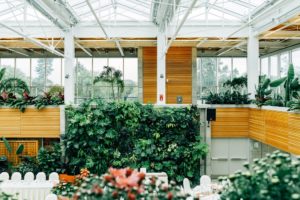What is Biophilic Design?
Biophilic design is about designing spaces with an emphasis on our innate connection and
attraction to nature and natural landscapes. The word combines the Greek bios meaning life and the
Greek philos meaning loving, and while experiencing biophilic designs might inspire a
zest for life itself, this life refers to nature—A design based on our love of nature.

Photo courtesy of Jason Leung.
This concept was first coined by the naturalist Edward O. Wilson in 1984. The paper “Biophilic Design in Office Buildings” says
of Wilson’s biophilia, “According to Wilson, humans have an instinctive bond with the natural world,
which has evolved over thousands of years of living in close proximity to nature.”
While indoor landscaping is only a part of biophilic design, it’s a very effective part.
Biophilic Design Improves Mood
It may seem too simple to be true, the idea that some well-placed plants can boost your mood
while you sit at the same desk staring at the same computer monitor as usual, but it truly works.
The aforementioned paper states, “Indoor plants play a significant role in biophilic design by
introducing natural elements and improving air quality. Research indicates that
indoor plants can reduce stress, enhance mood, and increase productivity.”

Photo courtesy of Sonnie Hiles.
In a previous blog we discuss a study that shows how workers in a space enriched with
plants outperformed those in a “lean” space stripped of all “non-essential” objects.
It might seem counter intuitive at first, one might assume that less stuff in the office equals less distractions.
But it’s not about less stuff, it’s about the right stuff, and that equates to indoor landscaping.
Biophilic Design Improves Concentration
Now that we know how biophilic design can boost one’s mood, it’s not difficult to understand
how it can help one’s concentration. Anyone who ever had to take a test knows that when you
feel good you perform better. This is very well documented regarding student performance
relating to access to food, hunger is a great distraction after all. But as humans,
we’re often starved for natural settings in our daily lives,
especially those of us that work in an office setting.

Biophilic design can help offset this deprivation we face by incorporating the outdoor
world into our workspaces. The paper “The Impact of Biophilic Learning Spaces on Student Success” states,
“Patterns in findings have emerged linking biophilic design with attention restoration to combat
mental fatigue, with stress recovery, enhanced creativity, relaxation, and excitement.”
It’s is a Win for Everyone!
It’s hard to argue against the benefits of biophilic design—It improves mood, concentration,
productivity, and overall wellbeing. Plus, it makes any space feel more alive and look more vibrant.
Workers and visitors alike will marvel upon entering your property when you incorporate these principles.

Courtesy of Design Details For the Built World.
As stated in “The Impact of Biophilic Learning Spaces on Student Success,”
The incorporation of these design principles in office buildings positively influences employee
well-being. The presence of natural elements, such as natural light, views of nature, indoor
plants, and the use of natural materials, contributes to higher levels of well-being,
job satisfaction, and reduced stress levels among office occupants.
Ready to Get Started?
Our team of experts are ready to help you turn your property into a biophilic wonder
through indoor landscaping. Watch the video under the link to
learn more about biophilic design and click the link below to get your quote today!
Get My Quote!
Featured Image courtesy of Chris Lee.





